1000/1000
Hot
Most Recent

Pillararenes trimer with particularly designed structural geometry and excellent capacity of recognizing guest molecules is a very efficient and attractive building block for the fabrication of advanced self-assembled materials. Pillararenes trimers could be prepared via both covalent and noncovalent bonds. The classic organic synthesis reactions such as click reaction, Palladium-catalyzed coupling reaction, amidation, esterification and aminolysis are employed to build covalent bonds and integrate three pieces of pillararenes subunits together into the “star-shaped” trimers and linear foldamers. Alternatively, pillararenes trimers could also be assembled in the form of host-guest inclusions and mechanically interlocked molecules via noncovalent interactions, and during those procedures, pillararenes units contribute the cavity for recognizing guest molecules and act as a “wheel” subunit, respectively. By fully utilizing the driving forces such as host-guest interactions, charge transfer, hydrophobic, hydrogen bonding, C—H…π and π—π stacking interactions, pillararenes trimers-based supramolecular self-assemblies provide a possibility in the construction of multi-dimensional materials such as vesicular and tubular aggregates, layered networks, as well as frameworks. Interestingly, those assembled materials exhibit interesting external stimuli responsiveness to e.g., variable concentrations, changed pH values, different temperature, as well as the addition/removal of competition guests and ions. Thus, they could further be used for diverse applications such as detection, sorption and separation of significant multi-analytes including metal cations, anions and amino acids.
Self-assembly has attracted much more attention in fundamental researches of material science and interesting applications to practical engineering areas [[1]], e.g., providing not only inspiring methodological strategy in processing, but also solid functional materials to balance morphologies and properties. Building ideal self-assembly begins from the molecular level [[1]], i.e., designing the structural geometry of molecules, modifying them with proper functional moieties, introducing and choosing proper inter/intramolecular interactions, as well as controlling the behavior of assembled molecules. Thus, designing appropriate building blocks from the molecular level is very significant in the construction of multi-dimensional self-assembly [[1]].
Macrocycles is a kind of particular cyclic oligomers with the hollow cavity for recognizing guest molecules [[1]], providing a possibility to introduce more functional and sensitive moieties for the fabrication of building blocks, as well as controllable self-assembly through supramolecular interactions such as host-guest interactions [[1]]. Pillararenes is a rising star in macrocycles [[1]], due to its high synthesis yield and convenient modifications. Different from other macrocycles, pillararenes composed by repeated phenol subunits possesses the electron-rich cavity and more rigid chemical structures, leading to its unique physiochemical properties such as planar chirality, as well as recognition towards neutral and electron-deficient guests. Interestingly, functionalized pillararenes monomers and dimers have been used as the building blocks to construct self-assemblies such as vesicular and polymeric architectures with small guest molecules as the template, but their morphologies are still limited [[1]].
To enlarge the family of assemblies with controllable multi-dimensional morphologies such as two-dimensional materials, pillararenes trimers have been designed and have attracted much more attentions recently. Different from pillararenes monomers and dimers, pillararenes trimers integrate three pieces of pillararenes units together via a “core” bridge, contribute a planar geometry as building blocks for advanced self-assemblies, and generate unique physiochemical properties such as aggregation-induced absorption [[1]]. We briefly summarized the recent progress about pillararenes trimers (PT1–PT10 according to the timeline, Table 1 and Scheme 1), their synthesis method, supramolecular interactions with e.g., guest molecules (G1–G9, Scheme 2), driving forces for self-assembly, the fabrication of advanced self-assembly, and current applications in the review [[1]]. We will try to find the issues and concerns in the development of pillararenes trimers and their advanced self-assembly. For example, pillararenes trimer could be prepared via both covalent and noncovalent bonds[[2][3][4][5][6][7][8][9][10][11][12]]. The selection of the synthesis strategy and functional precursors (Scheme 3 and Table 1) will become significant because it will further affect the molecular geometry including “star-shaped” molecules and linear foldamers, as well as driving forces for next-step self-assembly, e.g., by utilizing unoccupied pillararenes cavities via host-guest interactions or functional groups from modifications via other supramolecular interactions. In addition, the precise control over the self-assembly is always the key point during practical applications. Thus, we will analyze the sensitive supramolecular interactions of pillararenes trimers-based self-assemblies in details [[1]].
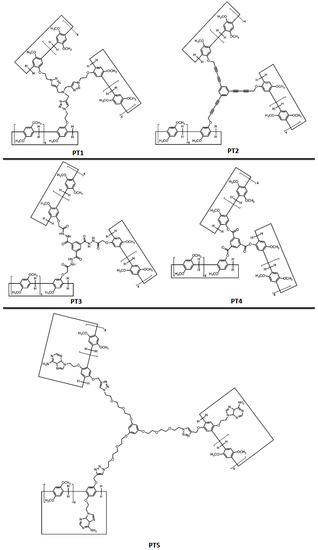
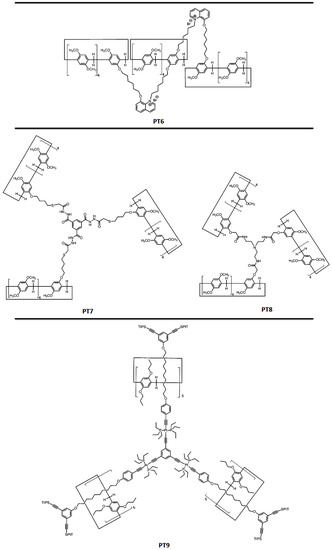
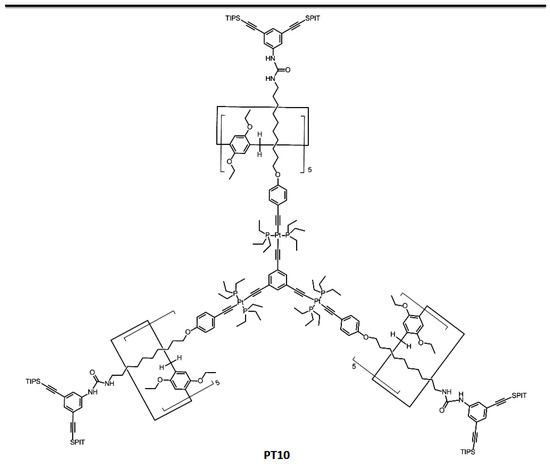
Scheme 1. Chemical structures of pillararenes trimers (PT1–PT10).
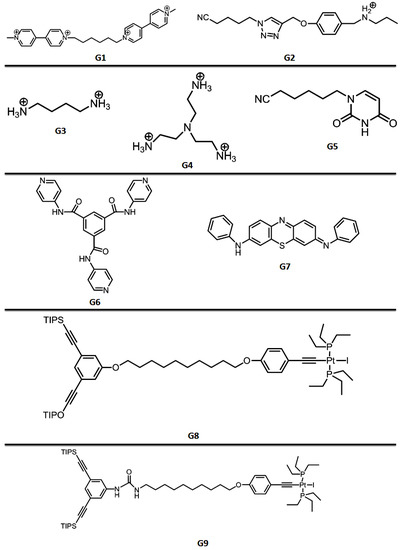
Scheme 2. Chemical structures of guest molecules (G1–G9).
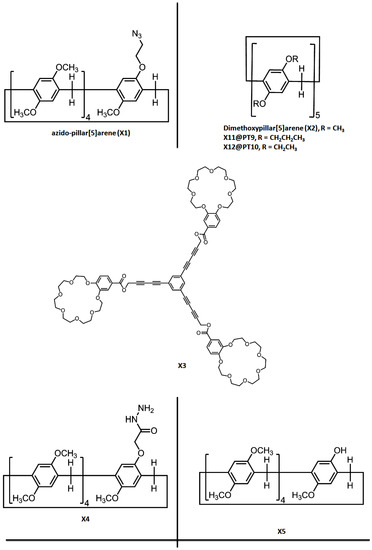
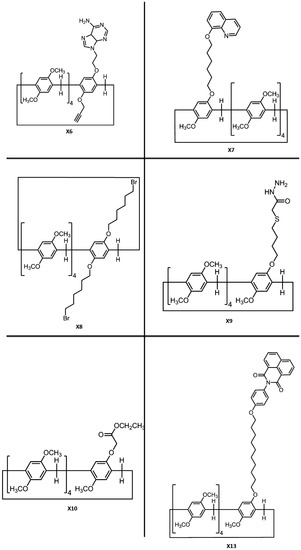
Scheme 3. Chemical structures of precursors for the synthesis of pillararenes trimer, as well as other significant building blocks for the construction of assemblies (X1–X13).
Table 1. Comparison of various pillararenes trimer (PT1–PT10), guest molecules (G1–G9), precursors, and other significant building blocks (X1–X13) for self-assembly and external stimuli responsiveness.
| Pillararenes Trimer | Guest | Precursor | Interactions | Assembly | External Stimuli | Applications | Ref |
|---|---|---|---|---|---|---|---|
| PT1 | G1 | X1 | Host-guest interactions | Hollow spherical, tubular and layered assemblies | Concentration-dependent | Morphological control in comparison with X2 | [[2]] |
| PT2 | G2 | - | Host-guest interactions | Supramolecular hyperbranched alternating polymers | K+ (crown ether X3) | - | [[3]] |
| PT3 | - | X4 | Hydrogen bonding, van der Waals forces, C–H…π and π–π stacking interactions | Supramolecular polymer | Cations | Fluorescence detection and separation of Hg2+ | [[4]] |
| PT4 | G3/G4 | X5 | Host-guest interactions | Supramolecular polymer | - | - | [[5]] |
| PT5 | G5 | X6 | Hydrogen bonding, π–π stacking and host-guest interactions | Hyperbranched supramolecular polymer | Heat and acid/base | - | [[6]] |
| PT6 | - | X7/X8 | π–π stacking interactions | (Metal ions coordinated) supramolecular organic frameworks | Fe3+/Hg2+/Cr3+ and CN−/H2PO4− | Fluorescence ultrasensitive detection | [[7]] |
| PT7 | G6 | X9 | Hydrogen bonding, C–H…π and π–π stacking interactions | Supramolecular polymer network/supramolecular polymer framework | Metal cations/anions/amino acid | Fluorescence detection/adsorption capacity for cations | [[8]] |
| PT8 | G7 | X10 | - | - | Competitive complexation with Anions | Fluorescence detection of F−/AcO−/H2PO4− | [[9]] |
| PT9 | G8 | X11 | Mechanical interlocked molecule | Dendrimer | - | - | [[10]] |
| PT10 | G9 | X12 | Mechanical interlocked molecule | Dendrimer | Dimethylsulfoxide and acetate anion | - | [[11]] |
| X13⸧G6 | G6 | X13 | Hydrogen bonding, π–π stacking and host-guest interactions | Supramolecular polymer networks/gel | Heat/cooling, pH, competitive guests and mechanical | Dye sorption, ultrasensitive detection and separation of Fe3+ | [[12]] |